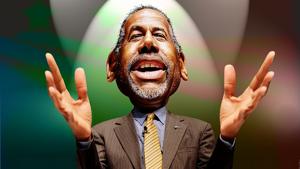Ben Carson Says He Wants To Help Working Families, Hands Massive Tax Break To The Wealthiest Instead

On Monday, Republican presidential candidate Ben Carson released his tax plan, the center of which is a flat tax of 14.9 percent.
Rather than different tax brackets for different income levels and categories, the flat tax levies the same rate on all personal and business income, although Carson’s 14.9 percent rate would only apply to people who have incomes above 150 percent of the poverty level, or $36,375 for a family of four. Those who make less would have to make a small tax payment: “Even those who earn little income will pay taxes, no matter how small their contribution might be,” Carson says in his plan. Currently, 46 percent of Americans don’t have to pay federal income taxes because their incomes are too low.
The plan also promises to get rid of deductions and tax breaks, such as the Earned Income Tax Credit or the Mortgage Interest Tax Deduction. It would also completely get rid of taxes on income from capital gains, dividends, and interest at the personal level — in other words, money made from investments — as well as the estate tax paid by 0.2 percent of Americans when property is transferred to heirs.
Carson’s reasoning for a flat tax is that the current code is “excessively long…complex
and incomprehensible,” and that his plan would save working families “wasted time, money and effort” who are already struggling to get by. But an analysis of his plan shows otherwise — that rather than helping out families who are struggling, it would overwhelmingly benefit the rich at the expense of those at the middle and bottom.
On a static basis — that is, without any assumptions baked in about how the plan might change economic growth or other factors — the Tax Foundation found that only the richest 10 percent would see a benefit. Everyone else would actually see their tax burdens increase. The top 1 percent would see an increase of after-tax income of 33.44 percent, while the bottom 10 percent would see a decrease of just over 13 percent.
Even when the analysis takes into account assumptions that the tax changes would increase growth — somewhat unlikely assumptions — the richest do the best, with the top 1 percent seeing the biggest benefit and those toward the bottom seeing less. After-tax income for the 1 percent would increase by nearly 45 percent, while it would go up by just 2.46 percent for the bottom 10 percent and only 0.51 percent for those just above them.

CREDIT: Tax Foundation
The plan would also cost the government a large amount of revenue — either $5.6 billion over a decade under a static model, or just under $2.5 billion under a dynamic one. That’s due in part to the loss of income tax revenue, but also a significant loss of corporate income tax revenue given that corporations wouldn’t have to pay the current on-paper 35 percent tax rate, but the 14.9 percent flat tax rate. Carson suggests that this will “create an environment that encourages corporations to bring their businesses back to America, invest money into our communities and create new jobs.” But there is no evidence high tax rates hurt the economy and companies that pay the highest effective rates actually create more jobs than those that pay less.
While Carson’s flat tax takes a different approach than many of the Republican presidential candidates, the outcome is similar. Plans released by Jeb Bush, Donald Trump, Ted Cruz, and John Kasich all give the biggest benefits to the wealthy rather than the poor or middle class.
***
This has been reposted from Think Progress.

